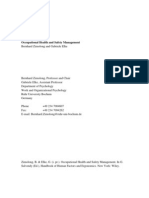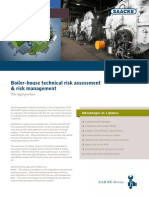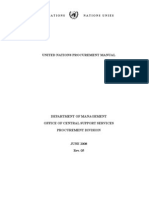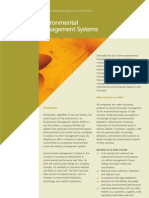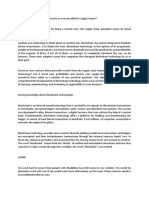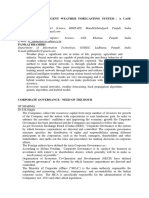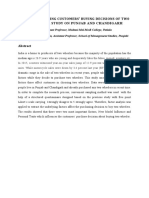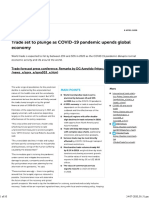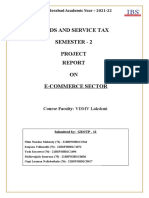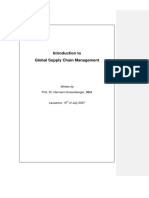Concept of Sustainable Supply Chain2
Concept of Sustainable Supply Chain2
Uploaded by
sanzitCopyright:
Available Formats
Concept of Sustainable Supply Chain2
Concept of Sustainable Supply Chain2
Uploaded by
sanzitOriginal Description:
Copyright
Available Formats
Share this document
Did you find this document useful?
Is this content inappropriate?
Copyright:
Available Formats
Concept of Sustainable Supply Chain2
Concept of Sustainable Supply Chain2
Uploaded by
sanzitCopyright:
Available Formats
13
2. Getting Started on Supply
Chain Sustainability
The first steps in developing a supply chain
sustainability programme are to evaluate the
business case for action and understand the external landscape. These efforts will help identify
the highest priority supply chain issues for your
company, evaluate risks and opportunities and
build the internal support to move forward.
Developing the Business Case
There are many compelling reasons for taking
action to improve social and environmental
impacts throughout the supply chain. Many
companies are driven by their corporate values
and culture to address sustainability issues. For
these companies, the fact that supply chain
sustainability is the right thing to do and is a
driver of social development and environmental protection helps create internal buy-in and
commitment.
Many companies also identify specific business drivers for supply chain sustainability.
The business case for a particular company depends on a variety of issues including industry
sector, supply chain footprint, stakeholder expectations, business strategy and organizational culture. Supply chain sustainability management practices that respond to multiple drivers
can maximize the value to business.
The most common business drivers for
supply chain sustainability are depicted in the
figure below.
building the business case for supply
chain sustainability 2
Business Drivers
for Supply Chain Sustainability
Managing
business risks
Minimize business
disruption from environmental, social and
economic impacts
Protect companys
reputation and brand
value
Realizing
efficiencies
Creating
sustainable
products
Reduce cost of
material inputs, energy,
transportation
Increase labour productivity
Create efficiency
across supply chains
Meet evolving customer and business
partner requirements
Innovate for changing market
Governance, Management, Transparency
From Business for Social Responsibility.
14 Supply Chain Sustainability
Meeting Business
Objectives through
Supplier Chain
Sustainability
Example of Risk Management: Partnering
with suppliers to ensure
minimum standards in
management practices,
such as minimum hiring
age, contracts with workers, health and safety
conditions, etc.
Example of Operational Efficiency: Reducing
costs without negatively
impacting operations,
such as shipping products via ocean freight
rather than via air cargo
when practicable.
Example of Sustainable Products: Sourcing raw materials with
social and environmental
impacts explicitly considered, such as biologically
based plastics that emit
relatively fewer greenhouse gases throughout
their lifecycle.
Managing Risk
Companies can protect themselves from
potential supply chain interruptions or
delays associated with suppliers human
rights, labour, environmental and governance practices by ensuring suppliers have
effective compliance programmes and
robust management systems covering all the
areas of the Global Compact Principles. For
companies who have a single source for key
inputs, managing risks is also critical to ensuring continued access to those resources.
Increasingly, customer and investor
expectations are driving companies toward
more responsible supply chain management.
Strong management of social and environmental issues can help companies address
reputational risks.
Finally, companies also use supply chain
sustainability to ensure that their suppliers
can adapt to anticipated strengthening of
environmental regulations, extended product responsibility legislation and to reduce
potential future liability.
Example: Westpac, an Australian bank, has
used advertising campaigns and sponsorships
to link the companys brand to social engagement, environmental protection and sustainability. Westpac recognizes that many of its
social, ethical and environmental impacts
reside as much in its supplier relationships (or
the supply chain) as in its own activities, and
that managing supply chain sustainability is
important to protect the companys reputation and brand value. Risks associated with
supply management include negative publicity,
damage to a companys reputation and actual
losses of customer base. Westpac carefully
manages these risks through a defined supply
chain management practice.
Realizing Efficiencies
A focus on realizing efficiencies in the supply chain can reduce your companys supply
costs while also reducing the environmental
footprint of your supply chain, including
energy, water and natural and synthetic
material use, as well as improving worker
health and, motivation, and productivity.
Benefits include:
Strong labour and health and safety practices which may result in cost efficiency and
improved productivity
Increased understanding of key processes
in the supply chain, including natural
resource management and extraction,
logistics and manufacturing, which enables
better management and stewardship of
resources
More efficiently designed processes and
systems which reduce required inputs and
lower costs
Productivity and efficiency initiatives require a full understanding of the different
steps of the supply chain and the key social
and environmental impacts and cost drivers. By addressing the root causes of issues
through strong communication capabilities,
in-depth understanding of business drivers and sustainability trends and shared
assessments and priorities for improvement,
companies can drive improvements and
derive the benefits.
Creating Sustainable Products
Collaboration with suppliers on sustainability issues can foster product innovation.
Companies embarking on such initiatives
have added new features and performance
characteristics to existing products and
even generated new products. For example,
sustainable products may result in fewer
negative environmental impacts than traditional products or have improved end of life
collection and disposal options. It is also possible for the sustainability of products to be a
differentiating factor and to lead to increased
sales for some companies.
Example: Ahlstrom Osnabrck, a Finnish
wallpaper company, began to develop products based on the Forest Stewardship Councils standard in the late 1990s after a large
customer in the United Kingdom announced its
commitment to source products that adhered
to the FSC standard. By 2010, all of Ahlstrom
Osnabrcks pulp suppliers were certified to
either the FSC or the Programme for the Endorsement of Forest Certification (PEFC) standards, and the company has 12 manufacturing
sites with FSC Chain-of-Custody certification,
allowing the company to meet increased
marketplace demand for certified sustainable
forest products.
15
The purchasing power of a
corporation can become a unique
driver for bringing about positive
change in society. Companies must
use this power to achieve a purpose
and make their supply chain a
vehicle for inclusive growth. In a
developing economy like India, the
bulk of the workforce is employed in
the unorganized sector which often
constitutes the last mile of the supply
chain. If this workforce is exposed
to the advantages of good and clean
business practices, it would make
a great impact on their lives and on
the wellbeing of the nation.
Anand Mahindra, Vice Chairman & Managing Director,
Mahindra& Mahindra Limited
16 Supply Chain Sustainability
Understanding
the External Landscape
Beyond identifying business drivers, it is also
important to understand the external landscape of supply chain sustainability including
the approaches of peer companies, the expectations of stakeholders and opportunities to partner with others (explored more in Chapter 8).
Benchmarking
against Peer Companies
Your peer companies may have already
begun addressing supply chain sustainability. Benchmarking against your peers may
provide you with a more sophisticated un-
derstanding of the business value as well as
ideas to incorporate into the design of your
supply chain sustainability programme. You
should seek to understand your peers:
Business case for supply chain
sustainability
Understanding of human rights, labour, environment and governance risks, opportunities and impacts and the resulting supply
chain focus
Internal structure for managing supply
chain sustainability
Codes of conduct, and the topics included
Use of their code of conduct
How does your Company Compare to Relevant Benchmarks?
Highlights from the 2009 Global Compact Survey Results Related to Supply Chain Sustainability
In 2009 the Global Compact conducted a survey of
its signatories, including questions related to supply
chain sustainability practices. More than 1,000 completed surveys were received from companies with diverse
profiles in size, geographic presence and industry.
regarding the assessment of current supply chain
partners, 36 per cent rely on audits by company staff,
35 per cent rely on self-assessment questionnaire
responses and 32 per cent assess corporate responsibility performance during regular business reviews.
83 per cent of respondents indicated they consider
suppliers adherence to the Global Compact principles,
and 46 per cent of respondents from companies with
more than 50,000 employees indicated they strongly
consider adherence to the Global Compact principles by
supplier. However, approximately 30 per cent of respondents from companies with fewer than 50,000 employees indicated they strongly consider adherence.
The largest companies (>50000 employees) indicated
they take a variety of actions to assist their supply chain
partners to improve and adhere to Global Compact principles, including providing training on specific issues (31
per cent), assistance with setting and reviewing goals
(26 per cent), reviewing and commenting on remediation plans (26 per cent) and providing references to third
party experts, e.g. consultants, civil society organizations (24 per cent). However, for smaller companies, the
top response in all size categories to this question was
no action taken.
Of the 17 per cent of respondents who do not consider
adherence at all, the top reasons for not considering
adherence included lack of capacity (28 percent), not
a priority (28 percent) and lack of knowledge how to
integrate principles with procurement practices (25
percent).
Among companies that consider Global Compact
participation when selecting supply chain partners,
regarding the selection of new supply chain partners,
45 per cent rely on publicly available information, 37
per cent rely on self-assessment questionnaires, 37 per
cent review other proprietary information and 32 per
cent rely on on-site audits by company staff.
Among companies that consider Global Compact
participation when selecting supply chain partners,
Some 52 per cent all companies, and up to 84
per cent of the largest companies include corporate
responsibility expectations in relevant documents (e.g.
contracts, proposal requests, and purchase orders).
Some 43 per cent of all companies and up to 72 percent of the largest companies, provide training to their
procurement staff on corporate responsibility.
However,
13 per cent of companies reward purchasing decisions that balance business and corporate
responsibility criteria and 15 per cent reward suppliers
that perform well on business and corporate responsibility criteria.
17
Approach and programmes to engage with
suppliers
Metrics to evaluate the success of their
programme
Reporting practices
Some industries have established joint codes
of conduct (see Chapter 3) and undertake
aspects of collaborative supplier engagement,
such as cooperation to conduct audits and
training. Benchmarking against peer companies can help you identify these collaborative
approaches and industry initiatives, which
are covered in detail in Chapter 8, to avoid
reinventing the wheel of supply chain
sustainability.
Finally, suppliers themselves can often
provide examples of good practices and
can communicate their needs to customers.
Understanding the
Expectations of Stakeholders
Companies should also invest in understanding the expectations of their stakeholders
including national and local governments,
workers and employers organizations, nongovernmental organizations (NGOs), advocacy
and activist organizations, academic and issue
experts and community groups, as well as
suppliers themselves.
Moreover, companies can also benefit from
seeking input from customers and investors.
Customer and investor demand is a primary
driver for many supply chain sustainability programmes, and insights from these stakeholders
can help shape programmes to ensure that they
create the maximum return for the company.
Engaging stakeholders early and regularly
in the process of designing a programme can
help companies identify relevant standards
and approaches to sustainable supply chain
management. Some stakeholders are knowl-
edgeable about, and sometimes even involved
in the development of, different codes of conduct and certifications for suppliers. Examples
include the Kimberly Process for jewelry,
Forest Stewardship Council Certification for
wood and paper products and the SA8000 for
responsible labour practices across industries.
They can help you evaluate the credibility of
different options and identify which might
be relevant inputs for your companys programme.
Emerging risks and opportunities in
supply chains. From customers and employees to activists and NGOs, stakeholders are
often the first to identify emerging environmental, social and economic issues in the
supply chain. Companies who engage early
and regularly with stakeholders have the
opportunity to take a proactive approach to
these issues and to partner with stakeholders
rather than discovering the issues through
an activist campaign. Early identification of
issues through stakeholder engagement can
also help companies take early leadership in
comparison to peers. See Chapter 8 for more
detail on multi-stakeholder collaboration.
Example: In developing its code of conduct,
Westpac consulted its Community Consultative Council, suppliers and NGOs. The company
included feedback from organizations such
as the Australian Conservation Foundation,
Australian Consumers Association, Australian Council of Social Security, Finance Sector
Union, Human Rights, and Equal Opportunity
Commission. Westpac listened and responded
to the issues raised by these groups. The
company also established a Sustainable Supply
Chain Management (SSCM) Policy Review Committee where internal and external stakeholders perspectives on SSCM can be heard and
used to improve its processes.
The Importance
of Investors and
Customers as
Stakeholders in
Supply Chain
Sustainability
Customers and investors
are increasingly expecting that companies
understand and manage
impacts in their
supply chains.
Investors want to ensure
that companies are
aware of and are mitigating key risks affecting
their supply chains.
In addition, they are
interested to know how
companies are creating
value from supply chain
sustainability.
Consumers and business customers are also
encouraging companies
to more closely manage their supply chains.
In particular, some
consumers are seeking more sustainable
products; while business
customers may include
supply chain sustainability in their supplier
selection criteria.
18 Supply Chain Sustainability
Establishing a Vision
Having a clear vision and objectives for
your companys sustainable supply chain
programme will provide direction for your
strategy and help to define your companys
commitment. A vision will be a helpful
yardstick in evaluating the success of the programme and in identifying areas for continued
improvement.
It is important that the development of
the companys vision and objectives are
championed from the top of your company.
This is critical to ensure the success of the
programme. Moreover, to ensure support from
company leaders, it is important for executives and senior managers from all parts of the
business related to the supply chain should
be consulted in this process and have a say
in the development of the companys vision.
Companies should consider how they can
include representatives from supply management functions such as procurement and
operations as well as corporate responsibility,
design, marketing, logistics, quality assurance, compliance, legal, human resources and
environment, health and safety functions in
creating the vision, as each of these functions
will have a role to play in the implementation
of the sustainable supply chain programme.
For smaller companies, it is equally important
that leaders agree on the vision for sustainable
supply chains.
The output of the process should be a
statement of vision and commitment. As you
develop the statement, consider what is motivating the company to invest in sustainable
supply chain management. Are you driven by:
Customer demands and concerns?
NGO and activist claims over practices in
your supply chain that affect your brand
and reputation?
Investor inquiries to understand how you
are managing supply chain risk?
Non-compliance with regulations and
standards that is preventing you from doing
business?
Rising costs as a result of increased demand
for and reduced supply of natural resources?
Pressure from your industry peers who are
also developing sustainable supply chain
programmes?
The companys culture of strong emphasis
and performance on sustainability?
Business interest in addressing macro issues
in the environment and society to ensure
long-term sustainability of operations?
It is also important to define specific objectives and potential barriers or risk events
affecting their achievement. What is the
company hoping to achieve through a supply
chain programme? What are some long-term
outcomes you want to work toward? How will
a sustainable supply chain support your companys business strategy? Objectives can vary
widely, including: strategic business goals (e.g.
creating long-term value for the company),
operational business goals (e.g. saving cost by
reducing wasted energy and materials), goals
to improve your companys reputation (e.g.
wanting to change stakeholder opinions of
your company), and compliance-based goals
(e.g. ensuring activities meet all applicable
laws and regulations).
Based on the business motivations and
objectives, you can craft a vision statement
that reflects what you consider long-term
success for a programme. Some examples of
company vision statements are provided in
the box at left. The vision for your company
may change over time. As you become aware
of issues and begin to understand and gain
experience, it may become necessary to reset the vision.
Example: Grupo Arcor, a food products and
confectionary business based in Argentina,
faced a growing number of requests and inquires
from clients, credit institutions, governments
and business chambers about the companys
supply chain and sustainability. As a result, the
company created a Supplier Social Responsibility Programme, founded on a vision to integrate
Grupo Arcors CSR Policy into its supplier relationships. Its specific objectives are:
To align suppliers with the companys CSR
practices and supplier contractual policies
To guarantee minimum common standards
in the companys production and management
processes based on sustainability
To increase and improve Grupo Arcors
supply sources while favoring the economic
inclusion of vulnerable groups with productive
activities which are normally excluded from the
competitive market.
The programme has three main strategies:
awareness and training; progressive CSR incorporation into the supplier recruitment policy;
and specific responsible purchasing projects.
19
Supply Chain Sustainability Vision Statements
LOreal
We are committed to building strong and lasting
relationships with our customers and our suppliers, founded
on trust and mutual benefit. We do business with integrity:
we respect the laws of the countries in which we operate
and adhere to good corporate governance practices.We are
mindful of our impact on the natural environmentWe are
committed to the respect of human rights. We want to end the
exploitation of children in the workplace and the use of forced
labourWe actively seek out and favour business partners who
share our values and our ethical commitments.
Nokia
At Nokia, we work hard to anticipate risk, demonstrate
company values, enhance our governance practices, increase
employee satisfaction, and look after the environment and
communities where we do business. We expect the companies
in our supplier network to take a similar ethical business
approach and to demonstrate progress and achievements in
these areas as well as in educating and overseeing the practices of their own suppliers.
Our aim is to ensure that environmental, ethical and health
and safety issues, as well as labour practices, are not separate
add-on features, but are embedded within all our sourcing
processes, including supplier selection and relationship development.
20 Supply Chain Sustainability
You might also like
- AIAG Cqi 14 Warranty Key TermsDocument13 pagesAIAG Cqi 14 Warranty Key TermsLipeca78% (9)
- Confirmations 07.24.2023Document62 pagesConfirmations 07.24.2023severusrapeNo ratings yet
- UNIT 1 MCQ With AnswersDocument11 pagesUNIT 1 MCQ With AnswersManoj Harry57% (7)
- Supply Chain Management. Lecture 1.Document13 pagesSupply Chain Management. Lecture 1.Hisham ShihabNo ratings yet
- Invoice - Packing List TemplateDocument3 pagesInvoice - Packing List TemplateMetzger Tamba KendemaNo ratings yet
- Environmental Safety Issues SCMDocument11 pagesEnvironmental Safety Issues SCMFadhili KiyaoNo ratings yet
- Week 7.1 Ethical and Sustainable SourcingDocument32 pagesWeek 7.1 Ethical and Sustainable SourcingRUSSELL WALDO PATRICIO MORALES100% (1)
- Concept of Risk ManagementDocument14 pagesConcept of Risk ManagementSuresh Gupta100% (1)
- B11 2 Human Factors in Safety 25 Mar 19Document2 pagesB11 2 Human Factors in Safety 25 Mar 19huijing966No ratings yet
- Managing Suppliers For Continuous Improvement: White PaperDocument6 pagesManaging Suppliers For Continuous Improvement: White Papervenkat raNo ratings yet
- A Safety and Health Management System Means The Part of The OrganisationDocument18 pagesA Safety and Health Management System Means The Part of The OrganisationMuhammad saad100% (1)
- Work Related Road Safety Literature ReviewDocument36 pagesWork Related Road Safety Literature Reviewmsn722005No ratings yet
- Chapter SIx - Sustainable SCM 2021 - 29 BatchDocument35 pagesChapter SIx - Sustainable SCM 2021 - 29 BatchFàrhàt HossainNo ratings yet
- Problem Solution - 5 Why's Analysis: ... Here Is Our "Wheel" Life ExampleDocument7 pagesProblem Solution - 5 Why's Analysis: ... Here Is Our "Wheel" Life ExampleisolongNo ratings yet
- Safety ManagementDocument127 pagesSafety Managements_krisrajNo ratings yet
- 01 Robert Conti Lean Production Job Stress 0240260904Document26 pages01 Robert Conti Lean Production Job Stress 0240260904Lisa Anggun SaraswatiNo ratings yet
- Environmental Report 2018 PDFDocument105 pagesEnvironmental Report 2018 PDFhemarubini96No ratings yet
- Safety Performance ProgramsDocument3 pagesSafety Performance ProgramsRandy Domingo FanerNo ratings yet
- 2015 EHS Challanges Enablon Reportv9Document15 pages2015 EHS Challanges Enablon Reportv9Anonymous sfY8T3q0100% (1)
- Critical Success FactorsDocument1 pageCritical Success Factorsvishmala25No ratings yet
- RRC Learning Resources BrochureDocument11 pagesRRC Learning Resources BrochuremashanghNo ratings yet
- Impact of Mentoring Functions On Career PDFDocument20 pagesImpact of Mentoring Functions On Career PDFHaseeb AhmadNo ratings yet
- Safety Culture Survey ReportDocument43 pagesSafety Culture Survey ReportClaireNo ratings yet
- Sustainable SourcingDocument30 pagesSustainable SourcingNguyen Thi Thoai AnhNo ratings yet
- 02 02 OrganizingDocument27 pages02 02 OrganizingrpjongNo ratings yet
- Human Factors Analysis and Classification System 38639Document11 pagesHuman Factors Analysis and Classification System 38639joframacoNo ratings yet
- Software Engineering Manager or Lead Software Engineer or SeniorDocument3 pagesSoftware Engineering Manager or Lead Software Engineer or Seniorapi-121667584No ratings yet
- Gibb, F. and Buchanan, S. (2006) - A Framework For Business Continuity Management. International Journal of Information Management 26 PDFDocument14 pagesGibb, F. and Buchanan, S. (2006) - A Framework For Business Continuity Management. International Journal of Information Management 26 PDFmichael17ph2003No ratings yet
- Risk Analysis Report Setup A New Assembly Line For Automotive ProductionDocument6 pagesRisk Analysis Report Setup A New Assembly Line For Automotive ProductionAmr EidNo ratings yet
- Osha-TOPIC 1: What Is Occupational Health and Safety?Document2 pagesOsha-TOPIC 1: What Is Occupational Health and Safety?AimuniMohdIsaNo ratings yet
- Maximo Change Management Quick Reference Guide v1.0Document5 pagesMaximo Change Management Quick Reference Guide v1.0ajayc50No ratings yet
- What We Know About Changing BehaviourDocument10 pagesWhat We Know About Changing BehaviourProfessor Jeff FrenchNo ratings yet
- Occupational Health and Safety ManagementDocument66 pagesOccupational Health and Safety ManagementGabriel Macedo100% (1)
- Environmental Sustainability A Complete Guide - 2021 EditionFrom EverandEnvironmental Sustainability A Complete Guide - 2021 EditionNo ratings yet
- SAACKE UK Boiler-House Technical Risk AssessmentDocument2 pagesSAACKE UK Boiler-House Technical Risk Assessmentashnee sewockNo ratings yet
- Healthy Work: Managing Stress in The Workplace: Health and Safety Is Good BusinessDocument22 pagesHealthy Work: Managing Stress in The Workplace: Health and Safety Is Good BusinessSanthoshi PriyaNo ratings yet
- Green ProcumentDocument5 pagesGreen ProcumentEngr Zain IshfaqNo ratings yet
- UN Procurement ManualDocument378 pagesUN Procurement Manuallengyianchua206No ratings yet
- Scoping Studies - Towards A Methodological FrameworkDocument15 pagesScoping Studies - Towards A Methodological Frameworkm.khalifa2264No ratings yet
- Alstom Sustainable Procurement Policy Jan 2022 enDocument2 pagesAlstom Sustainable Procurement Policy Jan 2022 encharles prabhakaranNo ratings yet
- Logist Ics Key Perf Ormance Indicat Ors (KPI)Document20 pagesLogist Ics Key Perf Ormance Indicat Ors (KPI)Paula Andrea Ñañez100% (2)
- Health & Safety Risk AssessmentDocument2 pagesHealth & Safety Risk AssessmentLina Inam100% (1)
- A Synergetic Model For Implementing An Integrated Management System: An Empirical Study in ChinaDocument8 pagesA Synergetic Model For Implementing An Integrated Management System: An Empirical Study in ChinaLora DoraNo ratings yet
- Marginal Costing FormulaDocument3 pagesMarginal Costing FormulashivaNo ratings yet
- Inherently Safer and More UserDocument8 pagesInherently Safer and More UseralijadoonNo ratings yet
- Safety and HealthDocument2 pagesSafety and HealthGonzalo Peñafiel VelasquezNo ratings yet
- Creating A New-Multistakeholder Methodology For Measuring ReputationDocument6 pagesCreating A New-Multistakeholder Methodology For Measuring ReputationDavid SelvaNo ratings yet
- 824WKS 15 HSWA Intro To The Health and Safety at Work Act 2015 Special GuideDocument82 pages824WKS 15 HSWA Intro To The Health and Safety at Work Act 2015 Special GuideMani SainiNo ratings yet
- Risk Management or Environmental Health and Safety or Safety ManDocument3 pagesRisk Management or Environmental Health and Safety or Safety Manapi-121419389No ratings yet
- Role of Procurement Best Practices in Mitigating Stock Outs in State Owned InstitutionsDocument62 pagesRole of Procurement Best Practices in Mitigating Stock Outs in State Owned Institutionsmainjosh1680100% (1)
- 7 Environmental Management Systems PDFDocument4 pages7 Environmental Management Systems PDFcoolgoroNo ratings yet
- Checklist of OHSAS 18001 Mandatory Documentation enDocument8 pagesChecklist of OHSAS 18001 Mandatory Documentation enMiguelGarcés100% (1)
- SustainabilityDocument22 pagesSustainabilityFadekemi AdelabuNo ratings yet
- (FREE PDF Sample) Lean Production Simplified A Plain Language Guide To The World S Most Powerful Production System Dennis Pascal EbooksDocument52 pages(FREE PDF Sample) Lean Production Simplified A Plain Language Guide To The World S Most Powerful Production System Dennis Pascal Ebookszofafouf100% (4)
- Now or Never: A New Bar For SustainabilityDocument30 pagesNow or Never: A New Bar For SustainabilityComunicarSe-ArchivoNo ratings yet
- Eia Project 3 Alaojipowerstationrep1Document171 pagesEia Project 3 Alaojipowerstationrep1Bakare Horlaniyi HaryodeleNo ratings yet
- ISO 14000 Environmental Management SystemsDocument28 pagesISO 14000 Environmental Management Systemssmacky777100% (1)
- Total Quality Management: Pakistan International AirlinesDocument6 pagesTotal Quality Management: Pakistan International AirlineshamidjavaidNo ratings yet
- Ebook Circular EconomyDocument239 pagesEbook Circular EconomyjiaathanasiaNo ratings yet
- Outsourcing of Humanitarian Logistics To Commercial Logistics Service ProvidersDocument23 pagesOutsourcing of Humanitarian Logistics To Commercial Logistics Service ProviderssanzitNo ratings yet
- Battery CalibrationDocument3 pagesBattery CalibrationsanzitNo ratings yet
- Insights On The Adoption of Social Media Marketing in B2B ServicesDocument41 pagesInsights On The Adoption of Social Media Marketing in B2B ServicessanzitNo ratings yet
- Is Blockchain Technology Necessary or Even Possible For Supply ChainsDocument5 pagesIs Blockchain Technology Necessary or Even Possible For Supply ChainssanzitNo ratings yet
- Humanitarian LogisticsDocument9 pagesHumanitarian LogisticssanzitNo ratings yet
- A Guide To Reverse LogisticsDocument4 pagesA Guide To Reverse LogisticssanzitNo ratings yet
- SSOM2 Ch03Document20 pagesSSOM2 Ch03sanzitNo ratings yet
- An Integrated Model For Logistics Network DesignDocument31 pagesAn Integrated Model For Logistics Network DesignsanzitNo ratings yet
- Job AnalysisDocument13 pagesJob AnalysissanzitNo ratings yet
- Warehouse OperationsDocument9 pagesWarehouse Operationssanzit100% (2)
- Distribution Network DesignDocument32 pagesDistribution Network Designsanzit100% (1)
- Factors Affecting Customers' Buying Decisions of Tw0 Wheelers-A Study On Punjab and ChandigarhDocument9 pagesFactors Affecting Customers' Buying Decisions of Tw0 Wheelers-A Study On Punjab and ChandigarhsanzitNo ratings yet
- Artificial Intelligent Weather Forecasting System: A Case Study Jasmeen GillDocument7 pagesArtificial Intelligent Weather Forecasting System: A Case Study Jasmeen GillsanzitNo ratings yet
- HRM 1Document22 pagesHRM 1sanzit100% (1)
- Course Structure: BBA Logistics and Supply Chain ManagementDocument2 pagesCourse Structure: BBA Logistics and Supply Chain ManagementsanzitNo ratings yet
- A Study of Influence Strategies Used by Children in Family Purchase DecisionsDocument8 pagesA Study of Influence Strategies Used by Children in Family Purchase DecisionssanzitNo ratings yet
- Factors Affecting Customers' Buying Decisions of Tw0 Wheelers-A Study On Punjab and ChandigarhDocument9 pagesFactors Affecting Customers' Buying Decisions of Tw0 Wheelers-A Study On Punjab and ChandigarhsanzitNo ratings yet
- WTO pr855Document10 pagesWTO pr855sanzitNo ratings yet
- Global Trade: UpdateDocument8 pagesGlobal Trade: UpdatesanzitNo ratings yet
- Harmeet Kaur@pimt InfoDocument7 pagesHarmeet Kaur@pimt InfosanzitNo ratings yet
- AssignmentDocument20 pagesAssignmentAfzal MahmudNo ratings yet
- Sap For Supply Chain Management: Presented By-Preeta HateDocument16 pagesSap For Supply Chain Management: Presented By-Preeta HatePreeta HaateNo ratings yet
- Goods and Service Tax Semester - 2 Project ON E-Commerce SectorDocument22 pagesGoods and Service Tax Semester - 2 Project ON E-Commerce SectorNitinNo ratings yet
- Netland and Alfnes (2008) A Practical Tool For Supply Chain Improvement - Submitted To POM TokyoDocument14 pagesNetland and Alfnes (2008) A Practical Tool For Supply Chain Improvement - Submitted To POM TokyoSyed Talal MohsinNo ratings yet
- Inventory Formula Excel TemplateDocument4 pagesInventory Formula Excel TemplateMustafa Ricky Pramana SeNo ratings yet
- A Handbook On Supply Chain Management For HIV AIDS Medical CommoditiesDocument69 pagesA Handbook On Supply Chain Management For HIV AIDS Medical Commoditiesamirq4No ratings yet
- Supply Chain Quality ManagementDocument4 pagesSupply Chain Quality ManagementkarimNo ratings yet
- Merchandising PDFDocument75 pagesMerchandising PDFSubramani Ss100% (1)
- Module Number 10 - Production Management - TQMDocument7 pagesModule Number 10 - Production Management - TQMEden Dela CruzNo ratings yet
- 1715744074-Ni Ketut Ayu Krisnawati-09-6C MBIDocument10 pages1715744074-Ni Ketut Ayu Krisnawati-09-6C MBIayu krisnaNo ratings yet
- A EFFSAA International FRDG 2018Document402 pagesA EFFSAA International FRDG 2018Wondwosen TirunehNo ratings yet
- Drivers of Amul Supply ChainDocument7 pagesDrivers of Amul Supply ChainChinmoy Das0% (1)
- Introduction To Global Supply Chain ManagementDocument48 pagesIntroduction To Global Supply Chain Management1234xxxxNo ratings yet
- E Commerce in Logistics and Supply Chain Management PDFDocument14 pagesE Commerce in Logistics and Supply Chain Management PDFVikram Pratap SinghNo ratings yet
- Introduction To Freight ForwardingDocument336 pagesIntroduction To Freight ForwardingAbdkarim Abbas Keder100% (1)
- Boeing SCM Ia1Document16 pagesBoeing SCM Ia1ParthShahNo ratings yet
- Answer 1: ProductionDocument4 pagesAnswer 1: Productionvivekbhardwaj 2k20umba49No ratings yet
- Logistics and Supply Chain Management: A Seminar Report ONDocument9 pagesLogistics and Supply Chain Management: A Seminar Report ONVivek D DeshmukhNo ratings yet
- Module 4 PDFDocument31 pagesModule 4 PDFWCC2 channelNo ratings yet
- Supply Chain Management NDocument288 pagesSupply Chain Management NInfotech Edge100% (1)
- List of Enterprises Registered To Benefit From Public Procurement ReservationsDocument92 pagesList of Enterprises Registered To Benefit From Public Procurement ReservationsGladys WambuiNo ratings yet
- Nvocc List 2023Document69 pagesNvocc List 2023Mannu GoyatNo ratings yet
- MCQ OSCM Unit 1Document22 pagesMCQ OSCM Unit 1ShammimBegum67% (6)
- Container Intelligence Monthly: Volume 21, No. 5 ISSN: 1467-0488 May-2019Document24 pagesContainer Intelligence Monthly: Volume 21, No. 5 ISSN: 1467-0488 May-2019avinash mohantyNo ratings yet
- SAP MM Inventory Management Mvt. Types and Their Purpose in Implementation ProjectsDocument4 pagesSAP MM Inventory Management Mvt. Types and Their Purpose in Implementation ProjectsRavindra GoliNo ratings yet
- BL Bill of Lading - EnglishDocument6 pagesBL Bill of Lading - Englishahmed tipuNo ratings yet
































